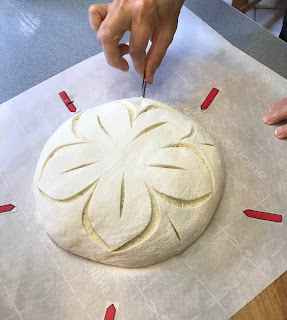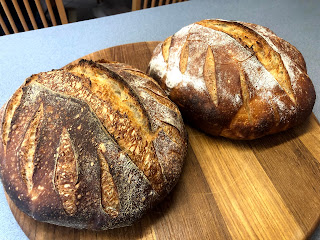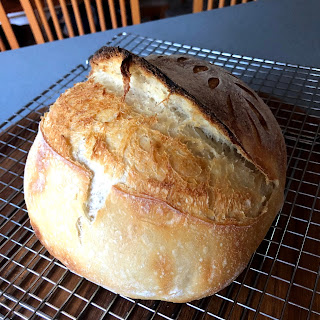We are making three loaves today.
Amy gets her own dough to work on.
This time, we took the starter out at midnight the night before and let it sit out on the counter.
When we woke up the next morning, we found the starter was very hungry and has grown a little bit even, waiting to be fed.
 |
| Starter is hungry and wants to be fed |
Amy is coming at 12 noon to mix the dough, so we waited for her.
 |
| Starter is ready to go to work |
For all 3 loaves, we are sticking to 75% hydration.
She picked up the techniques for stretch and fold really fast, and as a matter of fact, did an amazing job turning the dough over.
Amy agreed that feeling the texture of the dough was very addictive.
We had a nice lunch from 12 to 2pm, interrupted by the sessions of stretch and fold.
At 8pm, we pre-shaped and at 8:30pm, we shaped the dough and in the banneton baskets they went.
They retarded until the next day.
For the baking time, we have decided to put two ice cubes in the Dutch oven, and experimented with the baking time a little bit based on our readings on the internet.
 |
| Scoring Amy's loaf using her design selection |
Sourdough #20 (Amy's) baking time is the control:
1. Preheat the oven until the temperature reads 460 deg F (set at 500 deg)
2. Score using Amy's design selection
3. At 3:52PM, we put the dough and two ice cubes in the Dutch oven and reduce the setting to 450 deg for 15 minutes
4. We rotate the Dutch oven and wait another 15 minutes (temperature reads at 440 deg F)
5. We remove the lid and wait 7 minutes (temperature reads at 440 deg F)
6. We rotate and wait 5 minutes (temperature reads at 440 deg F)
7. We take the Dutch oven out and put the loaf on the bare rack then switch to convection for 2 minutes (temperature reads at 425 deg F)
8. We rotate the loaf and wait for the final 2 minutes
Sourdough #20 final weight: 763g
 |
| Sourdough #20 (75% hydration) with 2 ice cubes |
 |
| Sourdough #20: Amy stretched and folded and picked the scoring design |
 |
| Sourdough #20: crumb not completely dehydrated |
Onto sourdough #21.
Note that Sourdough #21 seems to be the least puffed up of the three, when compared in the banneton baskets.
Sourdough #21 baking time with a slight modification:
1. Preheat the oven until the temperature reads 460 deg F (set at 500 deg)
2. Score a fancy Honu with a Plumeria flour imprint
3. At 5:07PM, we put the dough and two ice cubes in the Dutch oven and wait 15 minutes
4. We rotate the Dutch oven, vent the lid, reduce the setting to 475 deg F and wait another 15 minutes (temperature reads at 450 deg F)
5. We remove the lid and wait 7 minutes (temperature reads at 430 deg F)
6. We rotate and wait 5 minutes (temperature reads at 435 deg F)
7. We take the Dutch oven out and put the loaf on the bare rack then switch to convection for 2 minutes (temperature reads at 440 deg F)
8. We rotate the loaf and wait for the final 2 minutes
Sourdough #21 final weight: 782g
 |
| Sourdough #21: 75% hydration, 2 ice cubes and venting the lid at 15 minutes |
 |
| Sourdough #21 (75%): great oven spring considering not a great rise in the banneton |
 |
| Sourdough #21 (75%): crust is extremely thin and crispy but the crumb is still wet |
We will try to extend the baking time for sourdough #22 as follows.
Sourdough #22 baking time:
1. Preheat the oven until the temperature reads 460 deg F (set at 500 deg)
2. Score
3. At 7:15PM, we put the dough and two ice cubes in the Dutch oven and wait 15 minutes
4. We rotate the Dutch oven, vent the lid, reduce the setting to 475 deg F and wait another 20 minutes (temperature reads at 460 deg F)
5. We remove the lid and wait 7 minutes (temperature reads at 430 deg F)
6. We rotate and wait 7 minutes (temperature reads at 435 deg F)
7. We take the Dutch oven out and put the loaf on the bare rack then switch to convection for 2 minutes (temperature reads at 440 deg F)
8. We rotate the loaf and wait for the final 2 minutes
Sourdough #22 final weight: 782g
 |
| Sourdough #22 (75%) with 2 ice. cubes and venting the lid at 15 min |
 |
| Sourdough #22 (75%): very good oven spring |
 |
| Sourdough #22 (75%) has the best rise of the three |









































